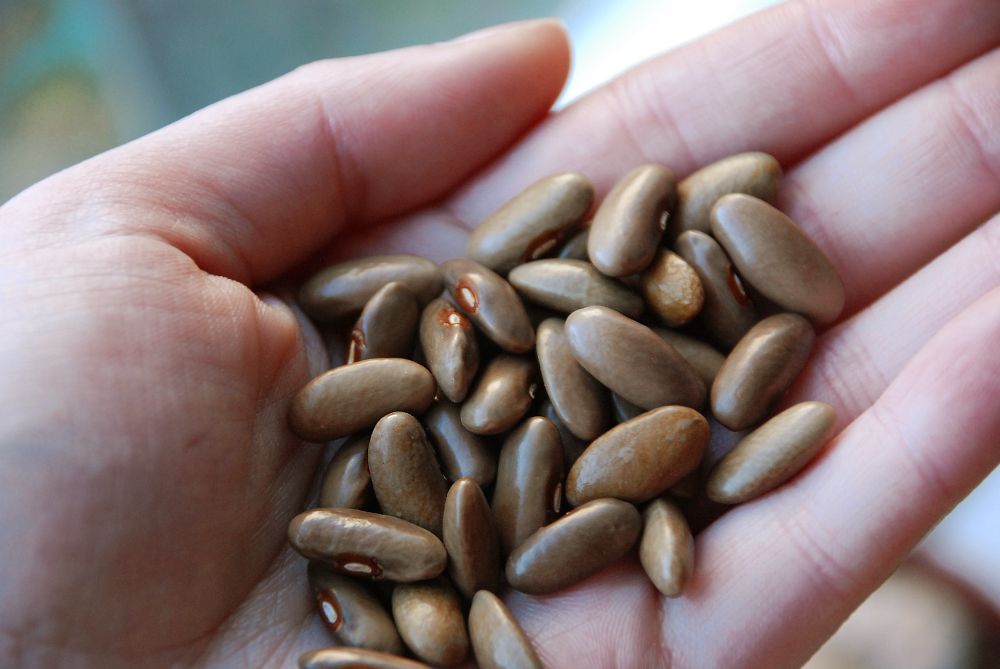
In March 2009 at a Seedy Saturday event I happened upon these beans. The story I was told that is associated with these beans is as follows:
Please note: the original quote below has proven to be a bit incorrect in its facts, and after about a year of searching and helpful folks sending me information, correct information has been added below. I am keeping this original quote, however, to simply document the process I went through acquiring information on these beans.
Before WWI a Chinese family had a farm down the valley from Nelson, BC. Up until WWI they grew tons of veggies. WWI came and unfortunately they lost their farm, and the family moved. Many years later, the daughter of the couple came back to the now deserted property and started looking through the sheds and buildings, looking for any property left behind. Remembering the beans specifically she searched for them, and found some old seeds in a shed. She brought the seeds and started growing them again, and now the seeds are becoming available to other growers via swaps/Seedy Saturdays/etc. It’s not available commercially.
In 2009 I grew them out and was amazed. They blew away every other bean variety that I was growing that year in vigour and harvest.
As a snap bean they have almost a buttery flavour (but aren’t a lima bean), and dried they were great in soups and chilies.
Further internet searching let me to finding this little snippet of information:
And in 2010, Annette from Vancouver Island was so kind as to send me this article from a now defunct publication, “The Island Grower”. Annette had originally received some Mr. Tung’s seeds from Irene Mollison (the lady who wrote the below article about the beans). I was absolute ecstatic to be able to hear the story directly from the family. I’ve quoted it below:
The following information was written and provided to The Island Grower by Irene Mollison (nee Kerr). it is a story about a special bean. According to Irene, the bean is delicious, and is served best by frenching before cooking. It is a stringless bean, and the dry seed pods are a beautiful shiny brown. She has generously agreed to send a few beans to interested readers if they include a self-addressed stamped envelope.
“My father, James D. Kerr came out from Englad at the age of 21 in 1906. he purchased 50 acres of land at Long Beach on Kootenay Lake. In those days the only means of transportation were the paddle wheel steamers, whose route was from Nelson up the Lake, calling in at all the small communities.
His property had to be cleared in order to plant orchards (apples, cherries, pears, raspberries, and strawberries, etc.). In order to do this heavy work with a team of horses and stumping powder, he hired a Chinese labourer, newly arrived in Canada, whose name was Tung. A shack was built for him on my father’s property, near the stables. He proved to be of great help to my father, staying with him 25 years, and endearing himself to the family.
My parents, James D. Kerr and Dorothy Lucy Eskrigge, were married in 1910 in Nelson, and I, Irene Kerr arrived a year later. Tung was in charge of the vegetable garden, and planted his beans in the garden, having brought the bean seed from China. These beans were incredible. The flavour wonderful. My grandmother, having lost her husband in 1909, bought an acre of land next to the ranch, and built her cottage there. In 1936 a killing early frost destroyed all the orchards in the whole valley. Tung then returned to his homeland permanently. Year after year we planted and enjoyed his beans.
In 1940, the ranch was sold and grandmother, who passed awa in 1921, left her cottage to me. I still own this cottage. All the orchard equipment, tools and garden equipment were stored in a shed on the property, as were the fruit baskets.
In 1947, after the war, my husband Donald Mollison and I moved into the cottage. For seven years (the war years) the cottage and property lay idle. My husband decided to tidy up the shed. I mentioned to him “if you find any little brown beans please bring them to me, as they are very important.” Later he came in with four beans he had found in one of the fruit baskets and said “Would these be the beans you were speaking of?” — I was delighted to find the four beans were in perfect condition, in spite of the years of dormancy. These were planted, for seed, and every bean grew perfectly — it was unbelievable! We planted the new seeds every year after.
In 1956 we moved to Victoria and I brought a good supply of Tung’s beans for many friends. We felt they were not quite as good as those that grew out at our cottage, perhaps due to the warm Kootenay climate. Our long-time gardener and friend, Bruce Saunders, has plented them year after year and enjoys them as much as we do.”
Mr. Tung’s beans have long, stringless green pods, reaching about 9″ per pod. The pods have approximately 8-10 beans, and fruit set is near 100%. There are 7 bean pods per shoot. Vines grow approximately 8ft. So that should give you an idea on how well these produce! They do very well in hot locations, and do well with some neglect since we often have water restrictions where I am. Where other beans failed, these thrived. They’ve become a staple in my garden.